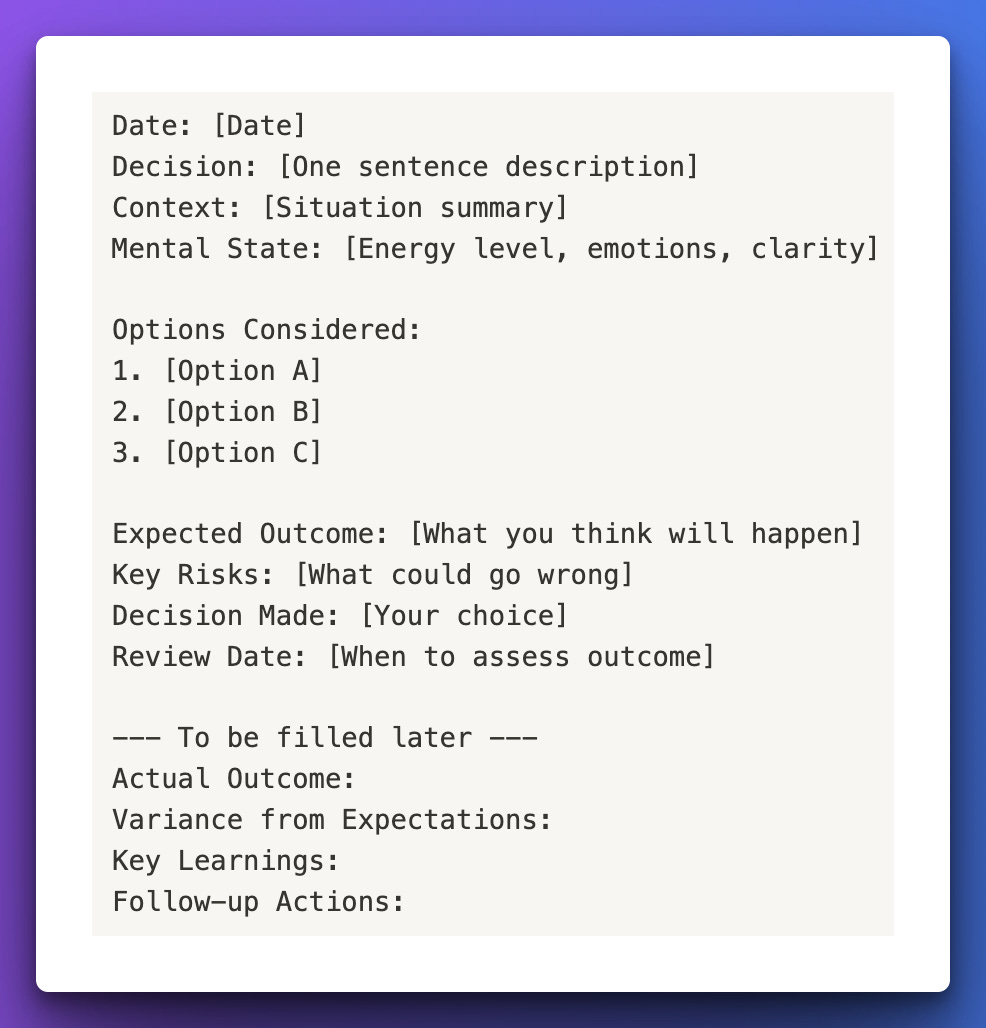🗒️ Decision Journaling 101
What is it and how to get started | Wisdom Letter 268
Decision journaling is a systematic method for recording and analyzing your decision-making process to improve future choices.
Its a great strategy to remove bias from the decision making process.
A mechanism to reflect on past decisions and improve from the mistakes you’ve made.
I too use it professionally on a regular basis - like for marketing campaigns in my business. But not so frequently personally.
I do like to use it for big life altering decisions though - stuff like when I quit my job to go on my own, or when evaluating a new venture that I want to try out.
Here’s how you can get started with a decision journal -
Core Components of a Decision Journal Entry
1. Decision Context
Date and time
Decision type (personal/professional/financial)
Time pressure level (urgent/moderate/relaxed)
Mental and physical state
2. Decision Framework
Problem statement
Options considered
Key uncertainties
Expected outcomes
Potential risks
Final choice made
3. Review Section
Actual outcome
Variance from expectations
Key learnings
Follow-up actions
Decision Journal Template
This is a what a typical decision journal entry will look like -
Applications Across Fields
Decision journals or some form of them are extensively used by professionals in different fields. I’m sure you must also be using some form of decision journaling at your job.
It’s just that we don’t apply the same rigour when it comes to our personal projects.
Here are a few examples of decision journals -
Trading & Investment
Entry/exit decisions
Position sizing
Risk management choices
Portfolio rebalancing
Management
Hiring decisions
Resource allocation
Strategic initiatives
Team restructuring
Product Development
Feature prioritization
Launch timing
Resource allocation
Technical architecture
Marketing
Campaign investments
Channel selection
Budget allocation
Messaging strategy
Sales
Deal strategies
Resource commitment
Pricing decisions
Territory planning
Best Practices
Record decisions immediately
Focus on process over outcomes
Be specific about expectations
Set concrete review dates
Include both successful and failed decisions
Common Pitfalls to Avoid
Over-analyzing small decisions
Skipping the review phase
Writing too much (keep it concise)
Focusing only on failures
Letting perfect be the enemy of good
Review Process
Schedule three types of reviews:
Quick Review (1 week after)
Medium Review (1 month after)
Long Review (3-6 months after)
During reviews, ask:
What went as expected?
What surprised me?
What would I do differently?
What patterns am I noticing?
Implementation Steps
Choose your most important decisions to track
Use the template as a starting point
Set calendar reminders for reviews
Look for patterns in your decision-making
Adjust your process based on insights
Remember: The goal is to improve your decision-making process, not to achieve perfect outcomes. Start small, be consistent, and focus on progress over perfection.
More on Decision Journals
Farnam Street has a good decision journal template to try out -
🤗 How can we help?
Whenever you’re ready, here’s how we can help you -
Looking to start your journey of solopreneurs? Grab The Solo Founder Playbook. (Free!)
Learn the top ideas, notes and summaries from the best personal development books in the world - Get the keys to wisdom
Make better decisions in the areas that matter - Health, wealth, and relationships - Get the mental models for busy professionals
Everything you need, to build life changing habits - The Toolkit for Atomic Habits
Quit your job and build a profitable business on your own terms. Get feedback, support, mentorship, connections, courses and lots more. - Join the tiny community for your big dreams.
That’s it for today.
See you next week 👋
We’ll be back with more interesting notes, highlights and curations.
Cheers,
Ayush & Aditi


